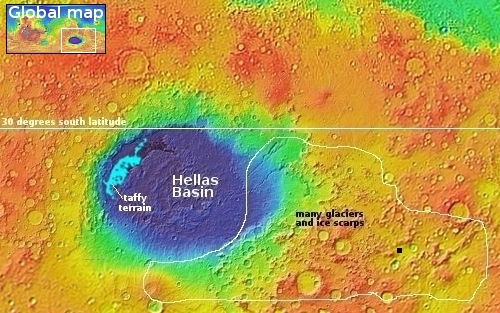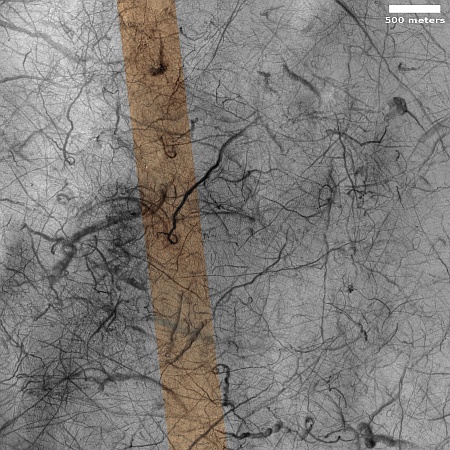Monitoring a changing spot on Mars
Cool image time! The picture to the right, cropped, reduced, and sharpened to post here, was taken on July 18, 2024 by the high resolution camera on Mars Reconnaissance Orbiter (MRO). Based on its label, “Dark Filamentary Streak Year-Round Monitor Site in Promethei Terra,” it was apparently taken as part of a long-term project to monitor the changes that occur at this particular spot on Mars.
This monitoring began in 2008, not long after MRO began science operations. In that first image, taken in the Martian autumn, almost the entire terrain was covered with dust devil tracks, all running more-or-less parallel to each other in a northwest-to-southeast direction.
That unusual tiger-striped landscape prompted later monitoring. However, a follow-up photo in 2010, also in autumn, showed practically no dust tracks here at all. Another image, taken in 2011 during the Martian summer, showed new dust devil tracks, but instead of being aligned as in 2008, the tracks went in all directions, with only a hint of alignment to the southeast.

Since then scientists have used MRO to monitor this site on a regular basis. In each case, the tracks appear to come and go, their pattern changing each time. I have tried to find a research paper based on these images, but have been unable to do so. That research would probably tell us if the changes are associated with the seasons, or with global or localized dust storms.
On the overview map to the right, the black dot inside the glacial region east of Hellas Basin marks this location, at 53 degrees south latitude. Despite being in the mid-latitudes and in a region where a lot of glacial features are found, this particular spot shows no such features. All the pictures show a relatively smooth landscape of very gently rolling hills, interspersed with a very small number of craters. While it is possible this entire surface is covered with ice (protected by a layer of debris), I have my doubts. In other places where the ground has lots of near-surface ice, there are always features that reveal its presence in some manner. In this case there are no such features.
On Christmas Eve 1968 three Americans became the first humans to visit another world. What they did to celebrate was unexpected and profound, and will be remembered throughout all human history. Genesis: the Story of Apollo 8, Robert Zimmerman's classic history of humanity's first journey to another world, tells that story, and it is now available as both an ebook and an audiobook, both with a foreword by Valerie Anders and a new introduction by Robert Zimmerman.
The print edition can be purchased at Amazon or from any other book seller. If you want an autographed copy the price is $60 for the hardback and $45 for the paperback, plus $8 shipping for each. Go here for purchasing details. The ebook is available everywhere for $5.99 (before discount) at amazon, or direct from my ebook publisher, ebookit. If you buy it from ebookit you don't support the big tech companies and the author gets a bigger cut much sooner.
The audiobook is also available at all these vendors, and is also free with a 30-day trial membership to Audible.
"Not simply about one mission, [Genesis] is also the history of America's quest for the moon... Zimmerman has done a masterful job of tying disparate events together into a solid account of one of America's greatest human triumphs."--San Antonio Express-News
Cool image time! The picture to the right, cropped, reduced, and sharpened to post here, was taken on July 18, 2024 by the high resolution camera on Mars Reconnaissance Orbiter (MRO). Based on its label, “Dark Filamentary Streak Year-Round Monitor Site in Promethei Terra,” it was apparently taken as part of a long-term project to monitor the changes that occur at this particular spot on Mars.
This monitoring began in 2008, not long after MRO began science operations. In that first image, taken in the Martian autumn, almost the entire terrain was covered with dust devil tracks, all running more-or-less parallel to each other in a northwest-to-southeast direction.
That unusual tiger-striped landscape prompted later monitoring. However, a follow-up photo in 2010, also in autumn, showed practically no dust tracks here at all. Another image, taken in 2011 during the Martian summer, showed new dust devil tracks, but instead of being aligned as in 2008, the tracks went in all directions, with only a hint of alignment to the southeast.

Since then scientists have used MRO to monitor this site on a regular basis. In each case, the tracks appear to come and go, their pattern changing each time. I have tried to find a research paper based on these images, but have been unable to do so. That research would probably tell us if the changes are associated with the seasons, or with global or localized dust storms.
On the overview map to the right, the black dot inside the glacial region east of Hellas Basin marks this location, at 53 degrees south latitude. Despite being in the mid-latitudes and in a region where a lot of glacial features are found, this particular spot shows no such features. All the pictures show a relatively smooth landscape of very gently rolling hills, interspersed with a very small number of craters. While it is possible this entire surface is covered with ice (protected by a layer of debris), I have my doubts. In other places where the ground has lots of near-surface ice, there are always features that reveal its presence in some manner. In this case there are no such features.
On Christmas Eve 1968 three Americans became the first humans to visit another world. What they did to celebrate was unexpected and profound, and will be remembered throughout all human history. Genesis: the Story of Apollo 8, Robert Zimmerman's classic history of humanity's first journey to another world, tells that story, and it is now available as both an ebook and an audiobook, both with a foreword by Valerie Anders and a new introduction by Robert Zimmerman.
The print edition can be purchased at Amazon or from any other book seller. If you want an autographed copy the price is $60 for the hardback and $45 for the paperback, plus $8 shipping for each. Go here for purchasing details. The ebook is available everywhere for $5.99 (before discount) at amazon, or direct from my ebook publisher, ebookit. If you buy it from ebookit you don't support the big tech companies and the author gets a bigger cut much sooner.
The audiobook is also available at all these vendors, and is also free with a 30-day trial membership to Audible.
"Not simply about one mission, [Genesis] is also the history of America's quest for the moon... Zimmerman has done a masterful job of tying disparate events together into a solid account of one of America's greatest human triumphs."--San Antonio Express-News



Looks like a retinal scan. Maybe it is.